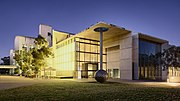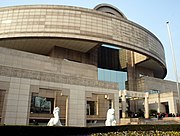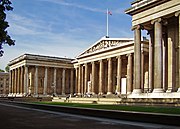Portal:Museums
A museum is an institution dedicated to displaying and/or preserving culturally or scientifically significant objects. Many museums have exhibitions of these objects on public display, and some have private collections that are used by researchers and specialists. Museums host a much wider range of objects than a library, and usually focus on a specific theme, such as the arts, science, natural history or local history. Public museums that host exhibitions and interactive demonstrations are often tourist attractions, and many attract large numbers of visitors from outside their host country, with the most visited museums in the world attracting millions of visitors annually.
Since the establishment of the earliest known museum in ancient times, museums have been associated with academia and the preservation of rare items. Museums originated as private collections of interesting items, and not until much later did the emphasis on educating the public take root. (Full article...)

The Rijksmuseum (Dutch: [ˈrɛiksmyˌzeːjʏm] ) is the national museum of the Netherlands dedicated to Dutch arts and history and is located in Amsterdam. The museum is located at the Museum Square in the borough of Amsterdam South, close to the Van Gogh Museum, the Stedelijk Museum Amsterdam, and the Concertgebouw.
The Rijksmuseum was founded in The Hague on 19 November 1798 and moved to Amsterdam in 1808, where it was first located in the Royal Palace and later in the Trippenhuis. The current main building was designed by Pierre Cuypers and first opened in 1885. On 13 April 2013, after a ten-year renovation which cost € 375 million, the main building was reopened by Queen Beatrix. In 2013 and 2014, it was the most visited museum in the Netherlands with record numbers of 2.2 million and 2.47 million visitors. It is also the largest art museum in the country.
The museum has on display 8,000 objects of art and history, from their total collection of 1 million objects from the years 1200–2000, among which are some masterpieces by Rembrandt, Frans Hals, and Johannes Vermeer. The museum also has a small Asian collection, which is on display in the Asian pavilion. (Full article...)

Cultural heritage management (CHM) is the vocation and practice of managing cultural heritage. It is a branch of cultural resources management (CRM), although it also draws on the practices of cultural conservation, restoration, museology, archaeology, history and architecture. While the term cultural heritage is generally used in Europe, in the US the term cultural resources is in more general use specifically referring to cultural heritage resources.
CHM has traditionally been concerned with the identification, interpretation, maintenance, and preservation of significant cultural sites and physical heritage assets, although intangible aspects of heritage, such as traditional skills, cultures and languages are also considered. The subject typically receives most attention, and resources, in the face of threat, where the focus is often upon rescue or salvage archaeology. Possible threats include urban development, large-scale agriculture, mining activity, looting, erosion or unsustainable visitor numbers. (Full article...)
- ... that the James Norman Hall Museum is where the The Bounty Trilogy was written?
- ... that the divers who found the c. 9th-century Tully Lough Cross in 1986 were convicted for trying to sell it to American museums?
- ... that two railroad boxcars were needed to ship William W. Jefferis's vast mineral collection to the Carnegie Museum of Natural History?
- ... that The Citi Exhibition: Manga at the British Museum was the largest exhibition of manga ever held outside Japan?
- ... that the Museum of Norwich at the Bridewell operated as a residence, a house of correction, a factory, and finally a museum?
- ... that a travelling museum exhibition in Japan displays "life-size" renditions of Pokémon skeletons alongside the fossils of actual prehistoric animals?
For editor resources and to collaborate with other editors on improving Wikipedia's Museums-related articles, see WikiProject Museums.
A national history museum or national historical museum is a history museum dedicated to presenting artifacts and exhibits reflecting the history of a particular nation, usually its home country. The earliest public museums, the Ashmolean Museum in Oxford and the Louvre Museum in Paris, were focused on natural history and art, respectively, and not necessarily on subjects related to the history of any nation. Following Napoleon's use of the Louvre as a center of national pride during his reign, other countries began to use museums not just to store artifacts of aesthetic or educational value, but to portray the country itself in a positive light.
Historically, some national history museums have been used purely as propaganda tools through which governments attempt to convey an official history. For example, "the Nazi regime employed the museum as a deliberate tool of propaganda and 'public education'". It has further been argued that "the very idea of an officially sponsored national history museum is simply outdated" in light of the trend towards pluralistic interpretation of artifacts. On the other hand, it has been argued that: "To create a national history museum that discards unitary national narratives as well as causal trajectories (the teleology of the nation)—in effect to subvert the form—is probably impossible". One concern of national history museums, therefore, is how to fairly and neutrally depict negative periods in a nation's own history. (Full article...)
Lists
- Museums
- Most visited museums (by region)
- Art museums: most visited, largest
Types
- Art museum
- Agricultural museum
- Archaeology museum
- Architecture museum
- Artillery museum
- Aviation museum
- Biographical museum
- Cabinet of curiosities
- Ceramics museum
- Children's museum
- Community museum
- Computer museum
- Design museum
- Dime museum
- Ecomuseum
- Economuseum
- Ethnographic village
- Farm museum
- Fashion museum
- Folk museum
- Food museum
- Green museum
- Hair museum
- Hall of Memory
- Heritage centre
- Historic house museum
- Human rights museum
- Imaginarium
- Interpretation centre
- Jewish museum
- Lapidarium
- Lighthouse museum
- Living museum
- Local museum
- Maritime museum
- Migration museum
- Mobile museum
- Museum ship
- National history museum
- Natural history museum
- Open-air museum
- Palace museum
- Postal museum
- Prefectural museum
- Print room
- Private museum
- Regimental museum
- Schatzkammer
- Science fiction libraries and museums
- Science museum
- Sex museum
- Sculpture garden
- Technology museum
- Textile museum
- Torture museum
- Toy museum
- Transport museum (list)
- University museum
- Virtual museum
- Wax museum
- Writer's home
Related
The following Wikimedia Foundation sister projects provide more on this subject:
-
Commons
Free media repository -
Wikibooks
Free textbooks and manuals -
Wikidata
Free knowledge base -
Wikinews
Free-content news -
Wikiquote
Collection of quotations -
Wikisource
Free-content library -
Wikiversity
Free learning tools -
Wiktionary
Dictionary and thesaurus

























































